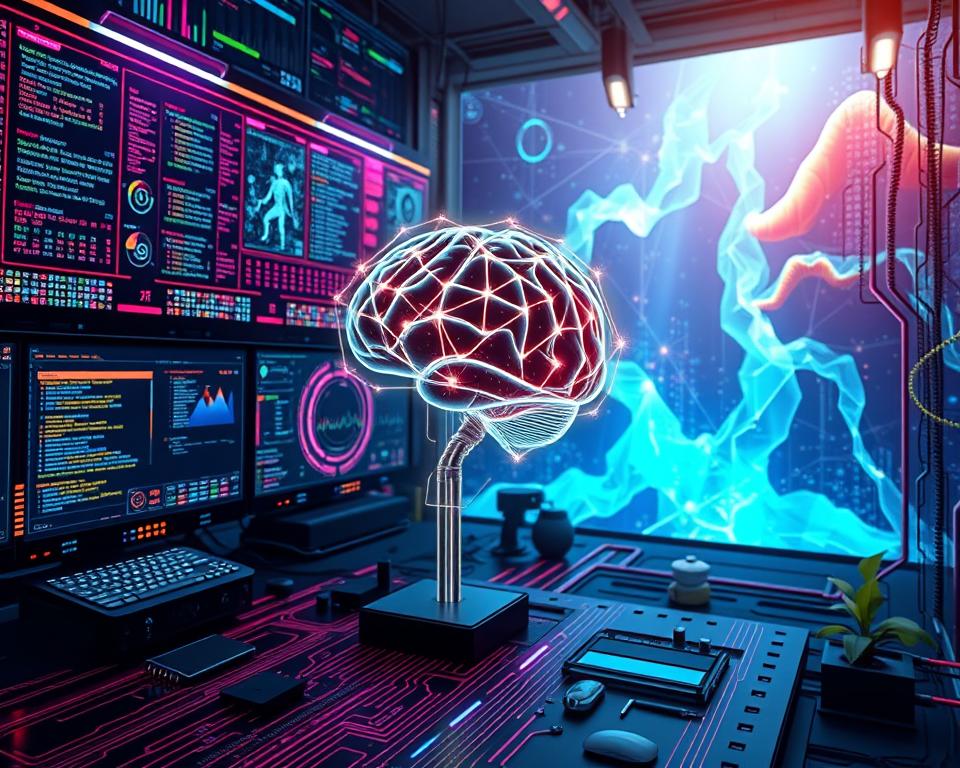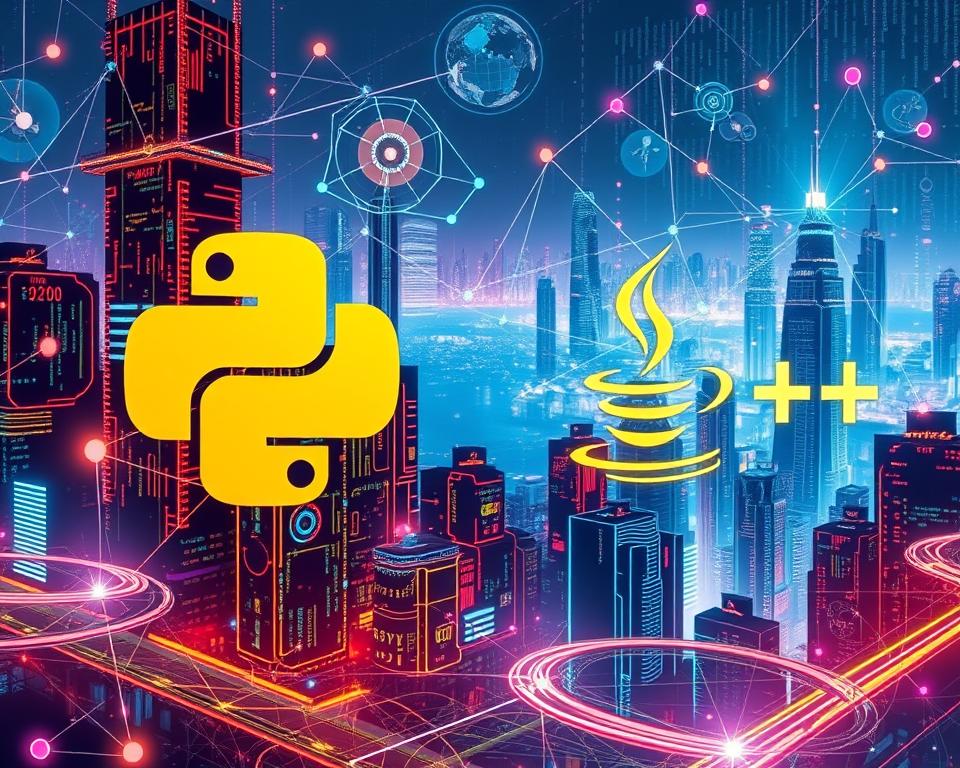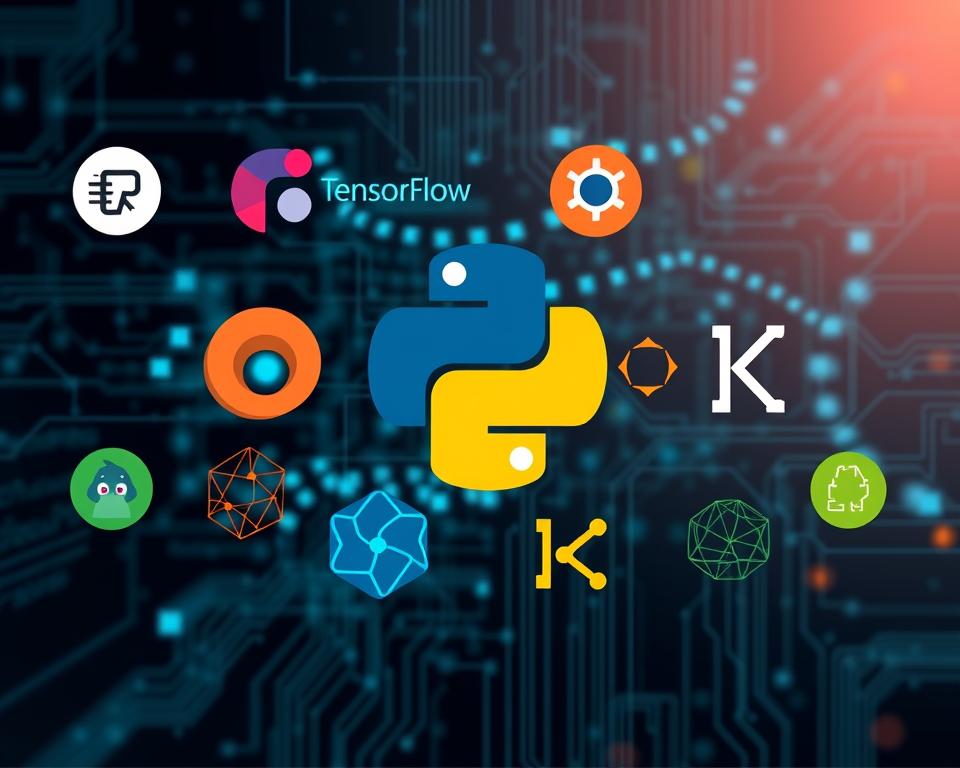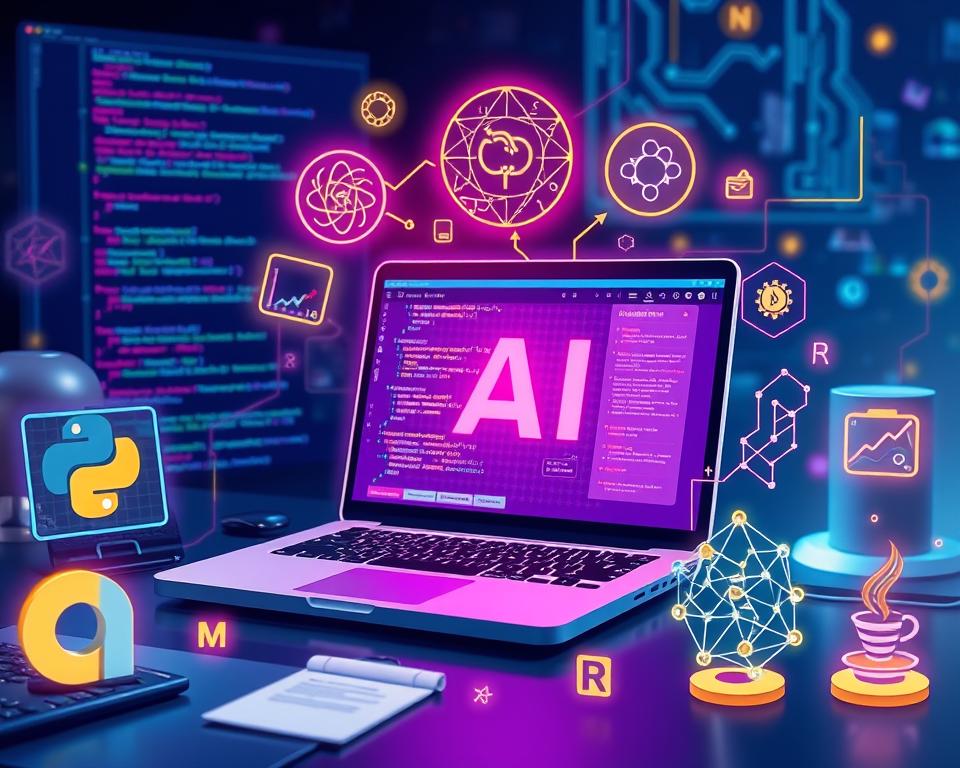Artificial intelligence (AI) is changing many industries fast. This means we need more skilled developers and engineers. Knowing the right programming languages is key for AI work, from machine learning to neural networks. This guide will look at the top programming languages for AI.
AI can handle huge amounts of data, driving innovation in many areas. Machine learning and neural networks, thanks to programming languages, have made big strides. These include natural language processing, computer vision, and predictive analytics. Knowing these languages is vital for anyone wanting to work in AI or data science.
Table of Contents
Key Takeaways
- Proficiency in programming languages is essential for successful AI development.
- Python, TensorFlow, and PyTorch are leading tools for machine learning and deep learning applications.
- Java and C++ play crucial roles in enterprise-level AI solutions and high-performance computing.
- R programming is a valuable asset for statistical analysis and data visualization in AI research.
- Emerging languages like Julia and MATLAB are gaining traction in scientific computing and AI prototyping.
Understanding the Role of Programming Languages in AI
Programming languages have been key in AI’s growth. As AI has become more advanced, the need for better programming languages has increased. Knowing about AI programming languages’ history and needs helps us understand AI’s future.
The Evolution of AI Programming
In AI’s early days, Lisp and Prolog were used for symbolic AI. Later, languages like Python and Java became popular. They support AI and machine learning well.
Core Requirements for AI Development
- High-performance computing for tough tasks
- Good data handling and processing
- AI-specific libraries and tools
- Scalability for big data and models
- Easy integration with hardware like GPUs
Language Selection Criteria
Choosing a language for AI involves several important factors. These include language efficiency, development ecosystem, and industry adoption. The right language balances performance, flexibility, and AI tools. Knowing these criteria helps pick the best language for AI projects.
“The choice of programming language can have a significant impact on the success of an AI project. It’s essential to carefully evaluate the language’s capabilities, ecosystem, and alignment with the project’s specific requirements.”
By looking at AI programming’s history and understanding its needs, we can make smart choices. This drives AI software development forward.
Python: The Leading Language for AI Development
Python is the top choice for artificial intelligence (AI) development. It’s known for its versatility, vast libraries, and simplicity. This makes it the favorite among data scientists, machine learning engineers, and AI researchers. Python excels in data manipulation and works well with the latest AI frameworks.
Python’s fame in AI comes from its strong Python AI libraries. Libraries like scikit-learn, NumPy, and SciPy offer essential tools for data science and machine learning. These tools make complex AI algorithms easier to use. This lets developers concentrate on the main ideas without worrying about the details.
| Python AI Library | Key Features |
|---|---|
| scikit-learn | Versatile machine learning library with a wide range of algorithms for classification, regression, and clustering |
| NumPy | Powerful library for numerical computing, providing efficient data structures and mathematical functions for array processing |
| SciPy | Comprehensive library for scientific and technical computing, including optimization, linear algebra, and signal processing tools |
Python’s easy-to-read syntax and vast library ecosystem attract both new and seasoned AI developers. Its simplicity and intuitive design enable quick prototyping and easy integration with other technologies. This solidifies Python’s role as the leading language for AI development.
“Python’s simplicity, readability, and vast ecosystem of libraries make it the perfect language for AI development, allowing developers to focus on solving complex problems rather than wrestling with the language itself.”
TensorFlow and PyTorch: Why Python Dominates Machine Learning
Python is the top language for artificial intelligence (AI) and machine learning (ML). This is thanks to TensorFlow and PyTorch, two big deep learning frameworks. They have made Python the best choice for creating advanced AI and ML models.
Popular Python AI Frameworks
TensorFlow, made by Google, and PyTorch, from Facebook’s AI lab, are key for deep learning. They have big libraries, fast GPU support, and easy APIs. This makes it simpler for developers to work on deep learning models.
These deep learning frameworks have helped Python become the top language for machine learning models.
Deep Learning Applications
TensorFlow and PyTorch are great for many deep learning applications. They help with image recognition, natural language processing, and more. These tools use GPU acceleration to speed up training and using models.
Neural Network Implementation
Python is easy to use and has lots of libraries, making it perfect for neural networks and machine learning models. Keras, built on TensorFlow, makes it even easier to work on deep learning models. This lets developers focus on solving problems, not getting bogged down in technical details.
Python’s success in AI and ML shows its flexibility and ease of use. It has a strong ecosystem of tools and libraries. As AI needs grow, Python will likely stay the top language for AI development.
Java’s Position in Enterprise AI Solutions
Java is now a key player in the growing field of enterprise-scale AI. It offers strong Java AI libraries and works well with existing systems. This makes Java a top choice for companies looking to use enterprise-scale AI.
Java is known for its performance, scalability, and security. It’s perfect for complex AI projects. Its use of the JVM makes it easy to add Java AI libraries and frameworks. This lets developers use AI in the Java environment they know well.
Java is also widely used in the enterprise, especially in critical applications and mobile platforms like Android AI development. This has made Java a top language for AI solutions.
| Advantages of Java in Enterprise AI | Challenges Addressed |
|---|---|
| Robust enterprise-level security and reliability | Ensuring the safety and stability of mission-critical AI systems |
| Seamless integration with existing business systems | Streamlining the deployment of AI within the enterprise infrastructure |
| Powerful Java AI libraries and frameworks | Leveraging advanced AI capabilities for complex business problems |
| Widespread adoption in mobile platforms (e.g., Android AI development) | Enabling the deployment of AI-powered applications on handheld devices |
As companies aim to use AI for innovation and to stay ahead, Java stands out. Its strong ecosystem and proven success make it a great choice for enterprise-scale AI. By using Java and the latest AI tech, businesses can find new ways to grow and improve in the digital world.
R Programming for Statistical Computing and AI
In the world of statistical computing and AI, R programming stands out. It’s known for its strong data analysis skills. This makes R a go-to platform for both researchers and developers.
Data Analysis Capabilities
R’s strength comes from its wide range of statistical analysis tools. It can handle everything from simple stats to complex models. Thanks to its vast library of R packages for AI, tackling predictive modeling tasks becomes straightforward.
Machine Learning Libraries in R
- The caret package: A unified interface for building and evaluating predictive models
- The h2o package: A scalable, distributed machine learning platform
- The xgboost package: A highly efficient and scalable implementation of gradient boosting
Visualization Tools
R also shines in data visualization. Tools like ggplot2 and Plotly help create beautiful, informative graphics. These graphics make complex data and AI insights easy to understand.
| R Package | Description |
|---|---|
| ggplot2 | A powerful data visualization library that enables the creation of publication-quality plots |
| Plotly | An interactive data visualization library that supports a wide range of plot types, including interactive maps and 3D visualizations |
| Shiny | A framework for building interactive web applications directly from R code |
Whether you’re an experienced data scientist or just starting with AI, R’s vast ecosystem is perfect. It offers top-notch tools for statistical analysis, data visualization, and machine learning. This makes R a key tool for AI development.
C++ in High-Performance AI Applications
C++ is a top choice for artificial intelligence, especially in high-performance computing. It’s known for its speed, efficiency, and control. This makes it perfect for real-time AI, game AI, and robotics programming.
C++ is great for real-time AI because it’s fast and efficient. It helps developers create AI that works quickly and accurately. This is key for things like self-driving cars, smart homes, and industrial automation.
Gaming also benefits from C++. It lets game developers make game AI that’s smart and fast. This gives players a more engaging and challenging experience.
C++ is also unmatched for robotics programming. It gives robotics engineers direct access to hardware. This lets them create efficient and responsive robotic systems.
| Application Area | Advantages of C++ |
|---|---|
| Real-time AI | High-speed processing, low latency |
| Game AI | Efficient resource utilization, responsive decision-making |
| Robotics Programming | Low-level control, performance optimization |
C++ is essential for high-performance AI. It offers unmatched speed, control, and efficiency. It’s a vital tool for AI developers working on advanced applications.
Programming Languages for AI Development: A Comprehensive Guide
The demand for artificial intelligence (AI) is growing fast. Choosing the right programming language is crucial for developers and companies. This guide will help you pick the best language for your AI projects.
Language Performance Metrics
When picking a language for AI, look at its performance. Speed, scalability, and memory use are key. Use benchmarking tools to compare languages and choose wisely.
Development Environment Considerations
The right development environment is important for AI work. Consider the code editor, debugging tools, and IDEs. Look for AI-specific tools and libraries to find the best fit for your team.
Industry Standards
Stay updated with AI trends and best practices. Know which languages are widely used and supported. This helps you make a choice that fits the future of AI.
| Programming Language | Performance | IDE Support | Industry Adoption |
|---|---|---|---|
| Python | High | Excellent | Dominant |
| Java | High | Excellent | Widely Used |
| C++ | Exceptional | Good | Prominent |
| R | High | Satisfactory | Prominent in Statistics and Data Analysis |
Think about these factors to choose the right language for your AI needs. This ensures your projects succeed and follow industry standards.
Julia: The Rising Star in Scientific Computing and AI
In the world of programming languages, Julia is making waves. It’s all about high-performance computing, numerical analysis, and scientific simulations. Researchers, data scientists, and AI fans are taking notice.
Julia stands out because it’s easy to use yet powerful. It combines the best of high-level languages like Python with the speed of C or Fortran. This makes it perfect for complex tasks that need speed and power.
The Julia ecosystem is growing fast, with more Julia AI packages being added. These tools help developers create advanced AI projects. Julia’s flexibility and performance are making it a strong contender in AI, alongside Python and R.
As the need for fast computing and AI grows, Julia is gaining ground. It’s all about efficiency, ease of use, and a growing community of tools. Julia is ready to shake things up in scientific computing and AI.
“Julia’s combination of ease of use and performance has made it a game-changer in the world of scientific computing and AI.”
| Feature | Julia | Python | R |
|---|---|---|---|
| High-Performance Computing | ✓ | ~ | ~ |
| Numerical Analysis | ✓ | ~ | ✓ |
| AI Ecosystem | ✓ | ✓ | ~ |
| Scientific Simulations | ✓ | ~ | ~ |
MATLAB for AI Prototyping and Research
MATLAB has found a special place in AI development. It’s a top choice for those working on AI projects. Its ability to handle signal processing and its use in schools make it very useful for AI work.
Signal Processing Applications
MATLAB excels in signal processing, which is key for AI. It can handle audio, images, and time-series data. This makes it easy to test and refine AI projects.
Academic Use Cases
In schools, MATLAB is a favorite for teaching and research. It’s easy to use and has lots of tools. This helps students and teachers explore AI ideas.
MATLAB is great for quick prototyping, deep research, and signal processing. Its wide use and strong features make it a key tool in AI.
| Feature | Benefit |
|---|---|
| Comprehensive Signal Processing Tools | Enables seamless integration of AI algorithms with various data types and formats |
| Intuitive and User-Friendly Interface | Facilitates rapid prototype development and experimentation |
| Extensive Documentation and Community Support | Provides a robust learning and troubleshooting environment for academic research |
Scala and Apache Spark for Big Data AI
Scala and Apache Spark are changing how we handle big data AI. Scala is a programming language that works well with Apache Spark. Together, they make solving big data problems easier.
Scala is great for creating complex AI libraries because of its clear and detailed syntax. It works well with Apache Spark’s MLlib library. This means developers can build advanced AI solutions for big data.
Using Scala and Apache Spark is beneficial because they can grow with your needs. Spark can handle big data well, helping find important insights. This makes them perfect for many AI tasks, like predicting trends and understanding language.
- Leveraging Scala’s functional programming paradigm for concise and expressive AI code
- Integrating Scala with Apache Spark’s MLlib for scalable machine learning tasks
- Harnessing the power of distributed computing to process and analyze big data efficiently
- Developing robust and maintainable AI applications with Scala’s strong type system
As more companies need big data AI, Scala and Apache Spark are becoming more popular. They offer great performance, scalability, and flexibility. This makes them a top choice for those looking to use their data to innovate.
JavaScript and AI Development in Web Applications
JavaScript is becoming a key player in web-based AI. Frameworks like TensorFlow.js make it possible to use AI directly in web apps. This opens up new ways for developers to create interactive and smart web experiences.
Browser-Based Machine Learning
TensorFlow.js has changed how web apps use AI. It lets developers add AI to their projects easily. This makes web apps more interactive and user-friendly.
Node.js AI Implementation
JavaScript is also used for server-side AI with Node.js AI frameworks. These tools help build smart backends for web apps. Developers can now create full AI solutions for their web products.
JavaScript’s role in AI is growing fast. With TensorFlow.js and Node.js AI frameworks, web apps will soon be even more dynamic and engaging.
| Framework | Description | Highlights |
|---|---|---|
| TensorFlow.js | A powerful JavaScript library for building and deploying machine learning models in the browser and on Node.js. |
|
| Brainjs | A fast, lightweight, and modular neural network library for Node.js and the browser. |
|
| Synaptic.js | A lightweight and versatile neural network library for Node.js and the browser. |
|
The need for web-based AI is growing. JavaScript’s role in AI will only get bigger. Developers using TensorFlow.js and Node.js AI frameworks will lead in creating smart web apps.
Go Language in AI Infrastructure
The Go programming language is becoming key for building AI systems that grow and work well together. It’s known for being simple, efficient, and great at handling many tasks at once. This makes Go perfect for creating fast AI microservices and systems that spread out over many computers.
Go is great for making AI apps that can handle a lot of data and work in parallel. It has special features like goroutines and channels that help with this. This is exactly what modern AI systems need to process lots of data and grow as needed.
The Go world is also getting bigger, with more AI libraries and tools coming out. There are tools like Gorgonia for machine learning and GoNLP for natural language processing. The Go community is working hard to make AI better within the language.



















